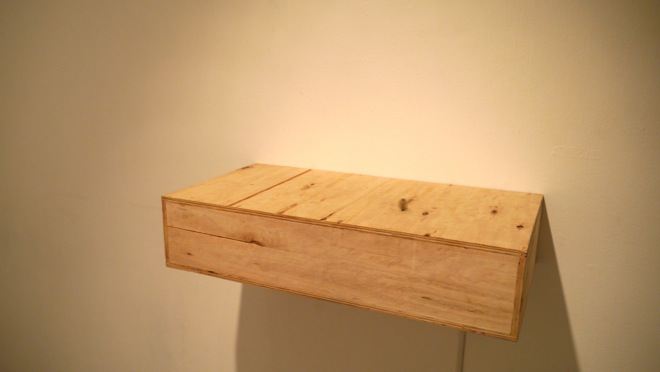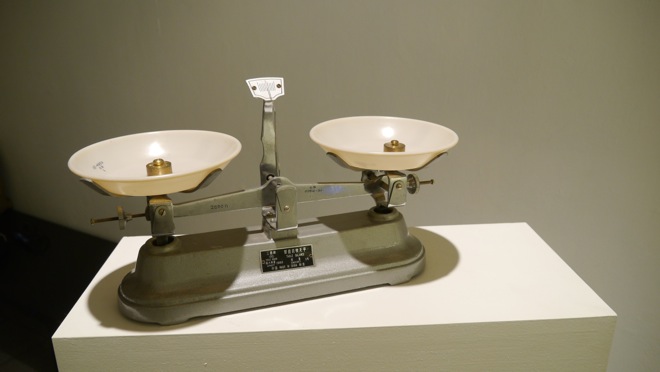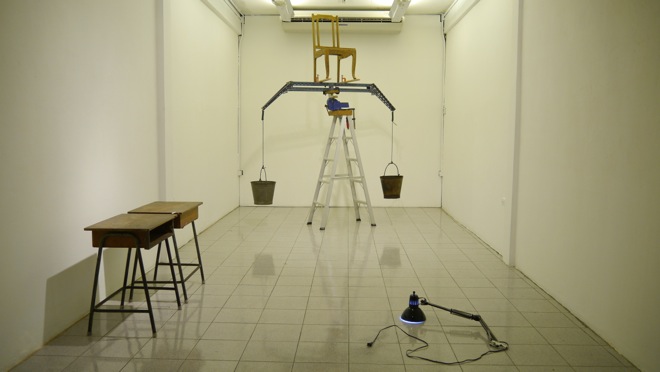“Unidentified Familiar Object”: solo exhibition by Makha Sanewong na Ayuthaya
WTF Gallery, Bangkok (#7, Sukhumvit soi 51, Bangkok 10110, Thailand), Aug 22–Sep 21, 2014
“Education should teach you to think logically. But in Thailand it’s the opposite right now,” asserts Makha Sanewong na Ayuthaya. Just 27 years of age and currently completing an MFA at the respected (if somewhat antiquated) Silpakorn University, Makha is surely one to watch closely in the crowded scene of young contemporary artists in Thailand. “Unidentified Familiar Object”, his first solo exhibition with hip hybrid space WTF, is impressively coherent in its understated physicality and its conceptual concern with the absurdity of contemporary politics in this nation of almost 70 million people, which has been subject to martial law since May this year. Makha’s work combines ingenuity with found materials with a biting, dark humor—with immediate and lasting effect.
Upon climbing the stairs to WTF’s split-level gallery space, the first piece that visitors will encounter is “Which Side?” (all works from 2014), consisting of a rough-hewn wooden box mounted to the wall, with a 10 baht coin spinning in perpetual motion. Upon closer inspection, a small hole beneath the coin and the low hum of a store-bought motor reveal the simple mechanics of this kinetic sculpture. Humble in scale, the work nevertheless wryly sets the tone for “Unidentified Familiar Object”.
Modest in scale and means, “Which Side?” is explained by the artist as an indictment of the pointlessness of the Thai education system. On one side of the 10 baht coin is an image of the Thai king, and on the reverse is an image of a Buddhist pagoda in Bangkok. Neither the monarchy nor religion are topics open for debate in Thailand, with the former protected by a strict lèse-majesté law implemented over a century ago. Yet even for viewers without knowledge of Thai cultural politics, the work might invoke a certain kind of bemused wonder at the futility and indecisiveness of a spinning coin that never settles on one side or another.


Sharing space with this work is “Not Stand, Not Fall”, the largest piece in the show. A row of wooden chairs lean against one another at a 45-degree angle, propped up by nothing more than a pencil. The chairs are of a kind instantly recognizable to most Thais as government-issue schoolroom furniture. The eloquent exhibition text asks “If you can’t sit on a chair, what good is it?” and provocatively suggests that Makha’s works “depict the logical fallacies of positions whose underpinning has largely been stripped away.”
Happily, the seriousness of such a task is offset by the playfulness of the work’s form. The repeated geometry of the boxy chairs initially recalls Minimalist sculpture, only for this apparent similarity to be neatly undermined by the insertion of the structurally essential yet formally incongruous pencil. As with “Which Side?” even viewers unfamiliar with the specificities of the Thai iconography and not attuned to Makha’s submerged social critique will still appreciate the hovering between balance and collapse in “Not Stand, Not Fall.”


Equilibrium, or the lack thereof, is also key to “Endless Unbalance,” a sculpture made from a vintage analogue scale, which (with the aid of another simple motor) has been set into a ceaseless cycle of rocking back and forth. The work’s flouting of expectations of this most basic of measuring instruments invokes a surprisingly torturous unease, aptly complementing the artist’s intended comment on the lack of impartiality and accuracy in contemporary Thailand.
On the same floor, “Is It Cool On Top?” is the title given to a wooden chair perched on top of a precarious platform balancing, literally, on a knife’s edge atop an industrial aluminium ladder. The symbolism here is surely the most heavy-handed in the exhibition, yet the work still rewards close attention, bringing to mind towers and elevated thrones, its clamped-together method of construction teetering between the structurally necessary and the flagrantly functionless.
Comprising just six sculptures, “Unidentified Familiar Object” is a tightly organized exhibition. Apparently, the artist’s process begins with hand-drawn sketches, followed by hand-made to-scale models. Only the most compelling plans finally materialize at full size in scavenged materials. The perhaps surprisingly methodical development of these works pays off in their restraint and concision.
The exhibition marks a subtle yet significant development from Makha’s first solo show, titled “Non Still Life” and presented at Pongnoi Community Art Space in Chiang Mai in 2011. While the previous exhibition also featured commonly available found objects transformed through the artist’s subtle interventions, the social critique was absent and the humor was less dark and more sensationalist. The earlier exhibition was explained by Makha as transforming the functions of everyday objects, while “Unidentified Familiar Object” might be better described as the deliberate rendering of ordinarily practical things as useless.
The wilfulness of Makha’s negation of use value mirrors the political situation in contemporary Thailand, albeit without violence or destruction in the gallery or studio. But more powerfully, the artist’s response, combining frustration with laughter, reflects a palpably widespread feeling in the nation today. While many of his generation throw up their hands in despair at Thailand’s seemingly intractable cycle of coups and corruption, Makha insists that he’s optimistic. The starting point for his creative process and for the experience of seeing his work is simply “having fun,” and the artist calmly says that he is “waiting for my time, for change.”

展览现场


